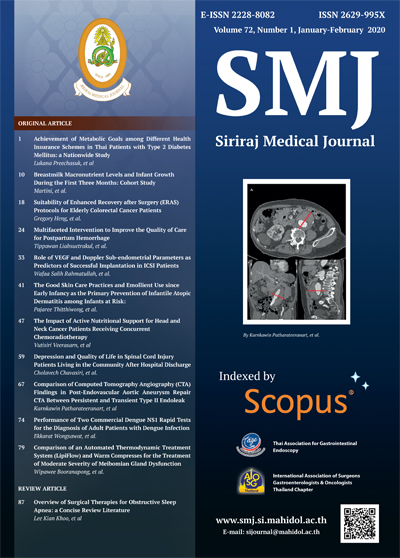Comparison of Computed Tomography Angiography (CTA) Findings in Post-Endovascular Aortic Aneurysm Repair CTA Between Persistent and Transient Type II Endoleak
Keywords:
Comparison, computed tomography angiography, CTA, post-endovascular aortic aneurysm repair CTA, persistent and transient type II endoleakAbstract
Objective: To compare first post-endovascular aortic aneurysm repair (EVAR) computed tomography angiography (CTA) imaging characteristics between transient and persistent type II endoleaks.
Materials and methods: This retrospective study enrolled patients who underwent EVAR and were diagnosed with type II endoleak from first post-operative CTA during January 2005 to October 2017 at the Department of Radiology, Faculty of Medicine Siriraj Hospital, Mahidol University, Bangkok, Thailand. Aneurysmal sac size, aneurysmal sac growth, and endoleak were recorded among patients whose endoleak disappeared within 6 months (transient group), and among patients whose endoleak persisted for more than 6 months (persistent group).
Results: Eighty-eight patients with a mean age of 75.3±7.3 years were included. Of those, 12 and 76 patients were in the transient group and persistent group, respectively. There were 71 males and 17 females. Univariate analysis showed number of feeding arteries (odds ratio [OR]: 9.9, p=0.012) and presence of inferior mesenteric artery (IMA) as an endoleak source (OR: 4.3, p=0.026) to be found more frequently in the persistent group than in the transient group; however, neither factor survived multivariate analysis. No significant difference between two groups was seen for endoleak diameter, endoleak complexity, or aneurysmal sac enlargement.
Conclusion: The number of feeder arteries and presence of IMA as an endoleak source on first postoperative CTA to be more likely found in patients with persistent type II endoleak. Further prospective study in a larger study population is necessary to identify any existing statistically significant differences and/or associations.
Downloads
Published
How to Cite
Issue
Section
License
Authors who publish with this journal agree to the following conditions:
Copyright Transfer
In submitting a manuscript, the authors acknowledge that the work will become the copyrighted property of Siriraj Medical Journal upon publication.
License
Articles are licensed under a Creative Commons Attribution-NonCommercial-NoDerivatives 4.0 International License (CC BY-NC-ND 4.0). This license allows for the sharing of the work for non-commercial purposes with proper attribution to the authors and the journal. However, it does not permit modifications or the creation of derivative works.
Sharing and Access
Authors are encouraged to share their article on their personal or institutional websites and through other non-commercial platforms. Doing so can increase readership and citations.











